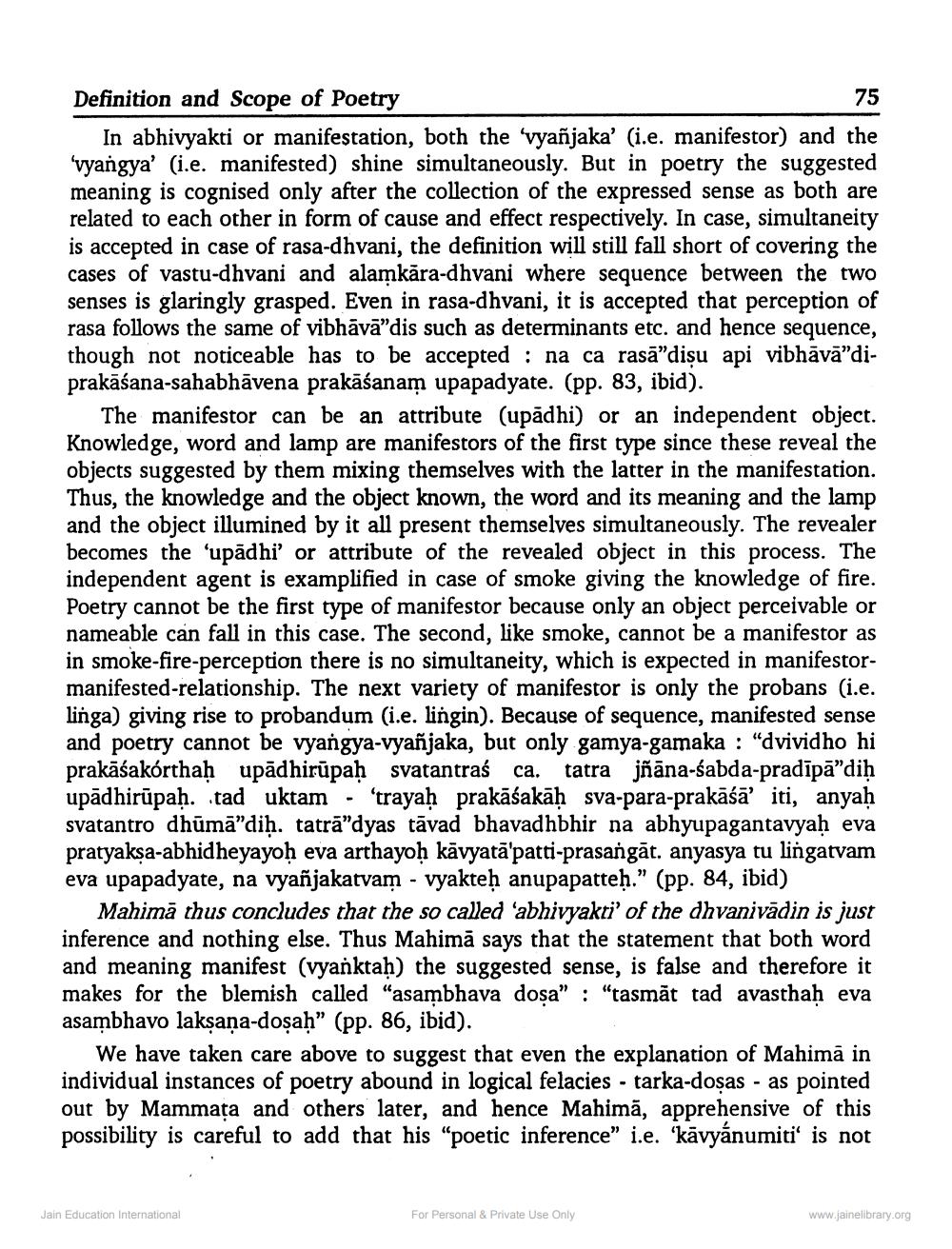________________
Definition and Scope of Poetry
75 In abhivyakti or manifestation, both the 'vyañjaka' (i.e. manifestor) and the vyangya' (i.e. manifested) shine simultaneously. But in poetry the suggested meaning is cognised only after the collection of the expressed sense as both are related to each other in form of cause and effect respectively. In case, simultaneity is accepted in case of rasa-dhvani, the definition will still fall short of covering the cases of vastu-dhvani and alamkāra-dhvani where sequence between the two senses is glaringly grasped. Even in rasa-dhvani, it is accepted that perception of rasa follows the same of vibhāva"dis such as determinants etc. and hence sequence, though not noticeable has to be accepted : na ca rasā"dişu api vibhāvā”diprakāśana-sahabhāvena prakāśanam upapadyate. (pp. 83, ibid).
The manifestor can be an attribute (upādhi) or an independent object. Knowledge, word and lamp are manifestors of the first type since these reveal the
bjects suggested by them mixing themselves with the latter in the manifestation. Thus, the knowledge and the object known, the word and its meaning and the lamp and the object illumined by it all present themselves simultaneously. The revealer becomes the 'upādhi' or attribute of the revealed object in this process. The independent agent is examplified in case of smoke giving the knowledge of fire. Poetry cannot be the first type of manifestor because only an object perceivable or nameable can fall in this case. The second, like smoke, cannot be a manifestor as in smoke-fire-perception there is no simultaneity, which is expected in manifestormanifested-relationship. The next variety of manifestor is only the probans (i.e. linga) giving rise to probandum (i.e. lingin). Because of sequence, manifested sense and poetry cannot be vyangya-vyañjaka, but only gamya-gamaka : "dvividho hi prakāśakórthaḥ upādhirūpaḥ svatantraś ca. tatra jñāna-sabda-pradīpā"diḥ upādhirūpah. tad uktam - 'trayah prakāśakāh sva-para-prakāśā'iti, anyah svatantro dhūmā"dih. tatrā"dyas tāvad bhavadhbhir na abhyupagantavyah eva pratyaksa-abhidheyayoh eva arthayoh kāvyatā'patti-prasangāt. anyasya tu lingatvam eva upapadyate, na vyañjakatvam - vyakteḥ anupapatteh.” (pp. 84, ibid)
Mahimā thus concludes that the so called 'abhivyakti' of the dhvanivādin is just inference and nothing else. Thus Mahim, says that the statement that both word and meaning manifest (vyanktah) the suggested sense, is false and therefore it makes for the blemish called "asambhava dosa" : "tasmāt tad avasthah eva asambhavo laksaņa-dosaḥ” (pp. 86, ibid).
We have taken care above to suggest that even the explanation of Mahima in individual instances of poetry abound in logical felacies - tarka-dosas - as pointed out by Mammața and others later, and hence Mahimā, apprehensive of this possibility is careful to add that his "poetic inference" i.e. 'kāvyánumiti' is not
Jain Education International
For Personal & Private Use Only
www.jainelibrary.org




